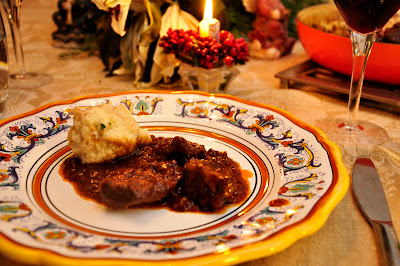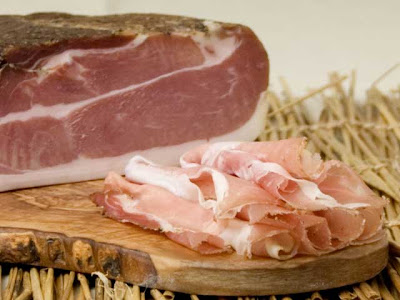Struffoli, small balls of dough fried and then covered in honey, is the quintessential Christmas sweet of Naples and its region of Campania. Although I don't have much of a sweet tooth, it is very dear to my heart; it was one of nonna Angelina's signature dishes, and it never failed to make an appearance each year around the holidays. In our family they were known as 'Nana's honey balls'. As a child I took the name literally, and until I moved to Italy, I thought that they were my grandmother's invention. You can imagine my surprise then, when, on vacation on the Amalfi coast one year, I peered into the window of a
pasticceria and saw... Nana's honey balls! Where on earth, I thought to myself, had they gotten the recipe? Well, I soon enough learned that Nana's secret recipe was actually no secret at all. In fact, the recipe is ancient, dating all the way back to the Greeks who settled southern Italy, founding, among other things the city of Naples or
Neapolis, meaning 'new city' in Greek.
In any event, these little babies are actually quite simple to make, but, like many old-fashioned dishes, they require a bit of time and tender loving care:
Ingredients (for a small plateful of stuffoli)300g (3 cups) flour
3 eggs
Butter, a walnut-sized chunk or 3 Tbs. oil
Rum, or other spirit (optional)
Zest of one lemon
Salt, a pinch
Vegetable (or olive) oil for frying
300g (1 jar) honey
Candied fruits (optional)
Confettini or candied 'sprinkles'
DirectionsYou begin by making dough with the first six ingredients. This was traditionally done by making what the Italians call a
fontana, or fountain of flour, in the middle of which you make a well for other ingredients, then slowly incorporating the flour into the well by hand as you beat the eggs and other liquid ingredients with a fork. These days, however, a stand mixer makes short work of this. Just put in your flour, then the other ingredients, and mix until you get a nice dough, just as if you were making pasta.
Once the ingredients have formed a smooth dough, form it into a ball and wrap it in plastic wrap. Let the dough rest for a good 30 minutes or so.
After the dough has rested, take a handful of it at a time and roll them out into 'cords' as if you were making gnocchi, about the thickness of your little finger (if you can manage it, otherwise as close to that as you can get). Then cut the cords into short lengths, again just like you are making gnocchi.
Take each little piece of dough, one by one, and quickly rub them between your palms in a circular motion to form little balls, the smaller the better. Place the little balls on a floured towel as you work, making sure that they are all in a single layer so they don't stick. Just before proceeding to the next step, you grab the ends of the towel and swish the balls around to lightly flour them.
Heat the oil in a large pan. You want lots of oil so the little balls can deep fry in it. When the oil is nice and hot, but not boiling, plunge the dough balls into the oil a handful at a time. The oil will immediately bubble up vigorously. Not to worry, it's supposed to be that way.
Fry the dough balls until they are lightly browned. Drain on paper towels while you proceed to the next step.
Now, in an ample sauté pan or saucier large enough to hold all of the dough balls, gently heat the honey until it liquifies. Add the dough balls, stir them gently to coat. Allow the balls to soak up the honey for just a minute or two. (They should not get soggy at all.) If using candied fruit (see Notes below) you will want to add some at this point.
Remove your
struffoli from the pan with a slotted spoon and arrange them on a plate. It is common to arrange
struffoli in a
ciambella or ring, but you can also simply pile them high. I like to form them into a little 'Mount Vesuvius' as picture above. Then sprinkle your pile with
confettini (or candy sprinkles). It is also customary to decorate and flavor
struffoli with candied fruits, in particular little bits of candied oranges and cherries, in addition to the spinkles. You can do this if you like, although—as far as I can remember—Angelina never did, so I follow suit. They can be eaten immediately, but improve with age.
NOTES: Although it takes a few steps, the recipe is really pretty much foolproof. The only
trick, the extent there is one, is to make your struffoli as small as you can manage, as that will mean more honey flavor and less chance of an undercooked middle.
There are a few
variations on the dish, although none that change its essential character. Like many traditional recipes, the original fat for both making and frying the dough was
strutto or lard, not oil. Today, it is more usual to use butter for the dough and vegetable or even olive oil for frying. Not all recipes call for the liquor. And some recipes call for orange rather than lemon zest. And the ratio of egg to flour varies from recipe to recipe. Here I have indicated the same 'golden rule' as for pasta dough: 1 egg per 100g (1 cup) of flour. But recipes may call for more or less egg, some for an extra yolk for color and richness. Some recipes omit the fat from the dough—be it butter, oil or lard—altogether, while others call for significantly more fat than indicated here. And, finally, some modern recipes, especially Italian-American ones, call for a pinch of baking powder, which lightens the honey balls considerably but is obviously a modern permutation.
To tell you the truth,
struffoli were not all that popular among the younger generation of my family. I like them well enough, but one of my sisters actively despised them. Being a natural born politician, however, that didn't stop her from complimenting our grandmother profusely one Christmas. Well, our ever thoughtful grandmother took note and the following Christmas brought a double batch of her 'honey balls', one for the family as usual, and another just for my sister, since she loved them so much! You should have seen the look on my sister's face as Angelina handed her that enormous second bag full of struffoli...





